1991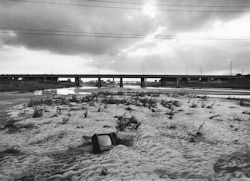 | 2006 |
The Proposal's Content The Ballot & Related Issues
The Oklahoman's Coverage All MAPS 3 News
The Mayor Who Set The Stage
Andy Coats Coats As Leader 3 Tax Efforts
Flashback Tax Attempt 1 Tax Attempt 2 Tax Attempt 3
The Mayor Who Got It Done
Enter the Dragon-Slayer: Ronald J. Norick The Mayoral Campaign Norick's 1st Months
In today's time, 16 years later, Oklahoma City voters are presented a new version of MAPS. When the original MAPS was voted upon, the anticipated cost was a mere $237.6 million — which, due to cost overruns and perhaps other matters, wasn't enough to get the job done — but, by five years later, results of MAPS were demonstrable and city voters almost gleefully voted to extend the tax by an additional 6 months so that the Ford Center and downtown library could be properly funded and built. In the original MAPS day, Oklahoma City voters had not been asked to tax themselves that much for anything so expansive or expensive. In this time, the MAPS 3 day, $237.6 million almost seems like chump change. The anticipated cost of MAPS 3, to be decided by city voters on December 8, 2009, would continue the penny sales tax for 7 years and 9 months at an anticipated cost of $777 million, almost treble the original MAPS expected amount.
This article focuses on the original MAPS initiative. It is hoped that the perspective and information provided will afford some useful data for comparing and deciding what to do about MAPS 3, 16 years later.
INTRODUCTION TO THE GIFT THAT WE GAVE OURSELVES. A December 14, 1993, Oklahoman editorial cartoon by the legendary Jim Lange showed Santa high in the sky and Oklahoma City's Christmas stocking just waiting to be filled. A colorized version of that cartoon is shown below (click here for the original) ...
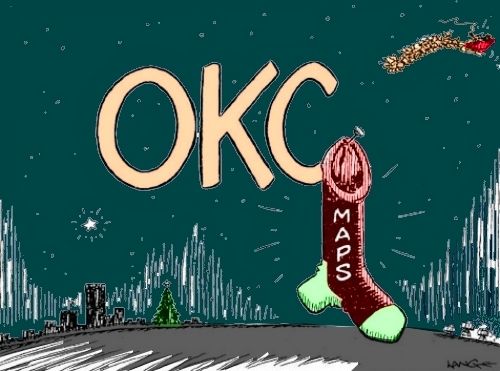
... but the story ain't as simple as Santa dropping off a package that would radically change Oklahoma City within a fairly short span of time and within our lifetimes. A whole heck of a lot of history would occur before that would happen.
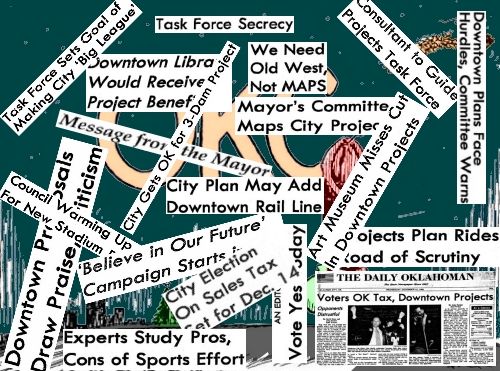
About This Article's Sources. This article tells a bit of that history based upon information contained in these two principal sources:
- The Oklahoman and Its Archives. My research for this article included locating and reading more than 80 articles located in the on-line Oklahoman archives, several of which were during Mayor Andy Coats term (April 1983 - April 1887) and Mayor Kirk Humphreys' two terms (April 1998 through November 2003 — the 2nd term being cut short when he resigned to run for U.S. Senate against Tom Coburn in November 2003) but the vast majority were during Mayor Ron Norick's two terms of office (April 1987 - April 1998).
MAPS 1 and Relevant History: Respect & Admiration. Having done that research, I must say this: I came away from that study being duly impressed with the Oklahoman's full presentation of news and issue discussion during that entire 20+ year span of time. Even though the Oklahoman's editorial position favored passage of each of the tax/bond issues presented during the span of this study, the Oklahoman's news position consistently presented all sides of the issues involved. The maintenance of a formal or informal fire-wall (so to speak) separating ownership's/management's opinions on one hand and unfettered news coverage on the other was both admirable and fully accomplished, from my observations at least.
MAPS 3 Reporting: Disappointment. Today, regrettably for us voters, and, to be sure, for what I would presume to be for the Oklahoman and its own self-esteem as a respected and card-carrying member of the 4th estate and all that such a title historically entails, such a bifurcation does not seem to be present. Concerning the current MAPS 3 news and analysis, the Oklahoman gives unmistakable signs and appearances of being disinclined to fully report both sides of the issues presented. At least, that is the opinion of this writer. For example, a well thought-through article presenting both sides of whether a new convention center was desirable appeared in a July 2009 article of the Oklahoma Gazette but nothing similar has appeared in the Oklahoman. More recently, a decision by the Fraternal Order of Police to oppose MAPS 3 has been reported in radio and TV media but was not reported in the Oklahoman.
By contrast, on the eve of the original MAPS vote but while the Oklahoman's editorial position was steadfastly pro-MAPS, the Oklahoman nonetheless carried a story written by John Parker bearing the headline below (click the headline for the full article) ... whether you liked E.L. Gaylord or not, he did not prevent the article below from being published ...
- Steve Lackmeyer & Jack Moneys' OKC: Second Time Around (Full Circle Press 2006). In this seminal book, the authors tell a much longer and more detailed story than I'll tell here — it is the bible for information about the entire relevant period of time (late 1950s through 2006) and you'll find none finer. I have been courteously allowed to present parts of their work in this article, and I thank the authors for that great courtesy.
That changed. So, where shall this particular story about MAPS begin ... three of the possibilities are ...
- The changing character of downtown. The development of large suburban shopping and entertainment districts was underway by 1950. For example, the Mayfair Shopping Center near NW 50th & May opened around late 1949 - early 1950; Sears, Roebuck & Co. moved from downtown to its new $3 million facility at NW 23rd & Pennsylvania in 1954; Reding Shopping Center at S. Western and SW 44th opened in late 1954; Penn Square Mall's construction plans were announced in 1955; and construction of the $15 million Shepherd Mall was announced on January 13, 1963 — located on a 54 acre tract in near northwest Oklahoma City on Northwest 23rd near Oklahoma City University, west of the Sears operation, it would be Oklahoma City's first enclosed shopping mall and would contain 70 stores and was said to be the largest of its kind west of the Mississippi River. Downtown was losing the battle of attrition to the new shops and theaters which offered free and easier parking.
- Urban Renewal. Beginning in 1962, Urban Renewal took hold of downtown and the time of the Pei Plan had arrived. Intended as a solution to (1), above, it was downtown's first extreme makeover, even if few would be found today to maintain that it was successful as it and downtown continued their slow death into the 1980s.
- The Oil Bust & Penn Square Bank's insolvency. The Oil Bust began around early 1982. By July 5, 1982, Penn Square Bank was declared insolvent and before all was said and done 139 other Oklahoma banks came to fail or be absorbed by other financial institutions, including, of course, the unthinkable — the failure of the First National Bank of Oklahoma City.
But, I'll not select any of those worthy topics as a beginning point for this article. For those stories, see Steve Lackmeyer & Jack Money's OKC: Second Time Around, mentioned above — is the singular and best place to go for all of that detail.
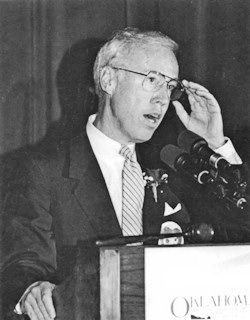 ANDY COATS — THE FORGOTTEN MAPS MAYOR. Instead of the above, I'll begin this story by writing about the period of time immediately following (3), above, Andrew (Andy) Coats, the period of time that Andy Coats was the city's mayor (between April 13, 1983, and April 14, 1987).
ANDY COATS — THE FORGOTTEN MAPS MAYOR. Instead of the above, I'll begin this story by writing about the period of time immediately following (3), above, Andrew (Andy) Coats, the period of time that Andy Coats was the city's mayor (between April 13, 1983, and April 14, 1987).After his mayoral term, he was elected to the Oklahoma Hall of Fame and presently serves as the Dean of the College of Law, University of Oklahoma.
Left photo: Mayor Coats delivering a State of the City address, probably in 1985, courtesy OKC: 2nd Time Around. Click on the image for a larger view.
I say "forgotten" since he is rarely if ever mentioned in connection with MAPS, a venture which, strictly speaking, began during the term of his successor in office, Ronald J. Norick. This section explains why, in my opinion, Andy Coats is integrally involved with a complete telling of the story of MAPS and how it came to be.
Coats The Leader. Mayor Coats was elected on March 15, 1983, by a 68% landslide majority and he took office on April 13. His four-year term was consistently marked by stark candor about the city and its unsatisfied needs and by his proactive leadership in attempting to find and implement means by which those needs would be met and the city would become turned around. He saw and spoke openly about the city that he loved as being in a period of doldrums if not decline while, at the same time, he vigorously led attempts to turn the ominous tide.
Setting aside the mayor's tax plans for a moment, this takes a brief look at him more generally as the city's leader.
Coats was vigorous in his support of the city at all times. In September 1983, he was on the bandwagon for the city to host a World's Fair. Click the headline below for the full article.

Part of the article reads,
Mayor Andy Coats' face lights up at the mere mention of Oklahoma City's bid to bring the World's Fair here in 1989. ¶ "If we can get it done and do it right, it would give us a chance to show Oklahoma City off to the nation and the world," Coats said.1989 being our city's centennial year, Oklahoma City began its push to be awarded the 1989 World's Fair in 1981. In September 1984, it became known that Knoxville and New Orleans had suffered losses during their hosting of similar events and the idea was nixed for Oklahoma City. For more about the proposed World's Fair, read this article. Mayor Coats was a huge supporter of Neal Horton's Bricktown venture. A 1983 video clip of the mayor interviewing Neal Horton will hopefully be up and running again at Steve Lackmeyer & Jack Money's OkcHistory.com — as this article is being written, the video is not presently available.
* * *
Hosting the World's Fair would give Oklahoma City a chance to overcome the hard knocks it has taken since Penn Square Bank was declared last year, Coats said. ¶ "I think we're not held in very high repute by the national business community because of the General Motors tax problem and the business losses caused by Penn Square Bank's collapse," he said.
In 1985, Mayor Coats championed a campaign to encourage Oklahoma Citians to think more positively about their city — a "Love" campaign. The mayor is shown below in a September 13, 1985, Oklahoman article below near an associated highway billboard. Click the image to read the full article.
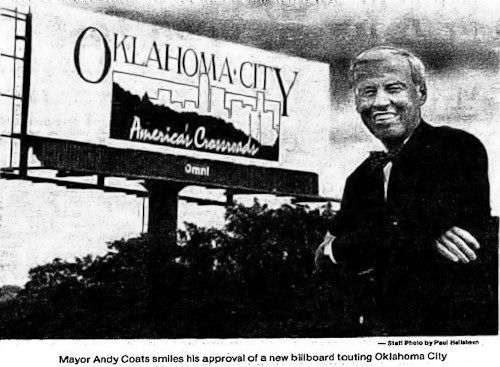
After a recent walk through the downtown area with Mayor Andy Coats, a group of New York visitors told the mayor "Oklahoma City has got to be one of the most beautiful places in the world," Coats said Thursday. "And as I looked at it through their eyes, it was so," Coats said.Three Tax Initiatives. As vigorous and valiant as his efforts were and despite his popularity, those qualities were not enough to accomplish a means of obtaining large amounts of new revenue for the city's existing or future needs. During his 4-year term, he would try to change that, three times.
* * *
"We have an unfortunate image of ourselves," he said. "We are somewhat apologetic about who we are."
* * *
To help battle the negative image, the mayor announced a new campaign "called very simply, 'We Love OKC.'" Billboards and bumper stickers will be part of the campaign.
In his first State of the City address on September 15, 1983, at a joint meeting of the Rotary Club, the Oklahoma City Chamber of Commerce and the South Oklahoma City Chamber of Commerce. Click the headline below to read its associated Oklahoman article.

If you want us to continue operating the city in a caretaker posture by fighting crime and fire with understaffed departments and putting Band-Aids on failing water and sewer systems, we will do the best we can with what we have.Although he didn't expressly announce his support for a lengthy sales tax increase to address the city's needs, he came close to it — see the Oklahoman's editorial interpretation of what he had to say. Among other things, the editorial said,
If, however, we are to build a great city, then we must have the vision and the courage to generate and spend the money necessary to ensure the highest quality of life for our people. I believe serious consideration must be given to raising city revenues.
But first things first. Citizens will want to see clearly how the money will be spent before they jump on any tax-increase bandwagon.Although blunt about the city's needs, the mayor's 1st State of the City address was cautious and unspecific about the path of remedy — it presented no grand vision, no specifics as to a path which Oklahoma City might follow to exit its period in the wilderness, so to speak. While the address was wholly logical and sensible, it lacked the element of a vision, a dream, from and in which lofty goals could be seized and embraced by the public.
The above Oklahoman editorial was correct — in his address, Mayor Coats did not specifically enumerate a goal-path of his vision that would be pursued. But that was because an existing goal-path had not yet been resolved and was still in place as the city's dream for the future — Urban Renewal. Let's step back in time for a moment before looking at the mayor's tax proposals.
Proposed Tax #1. After the Mayor's State of the City September 1983 address, mayor and council agreed to submit a very general sales tax initiative to the people. An October 14, 1983, Oklahoman article reported that,
Flashback: The Remnants of Urban Renewal.
In all fairness to the mayor, the city's existing visionary plan, Urban Renewal, had not yet come to its end and that plan was still on the table. So, at the time of Mayor Coats' 1st State of the City address, no need existed to enunciate some new grand vision for the city ... the old one hadn't played out yet and a newly announced one would have doubtless caused city-wide confusion if not apoplexy.
Before Coats was elected, On April 26, 1978, Vincent A. Carrozza had been selected by the Oklahoma City Urban Renewal Authority to develop the crown jewel of the plan, the 4-block downtown Galleria area which included the proposed shopping mall and two or three adjacent stunning new office buildings. Although One Galleria Tower (the Oklahoma Tower) and Two Galleria Tower (Corporate Tower) did get done by Carrozza, another 50-story tower and the Galleria mall did not. After being granting a brief extension to deliver a concrete plan to accomplish the shopping mall, Carrozza's contract was terminated by the city in May 1983.
Aside from the Galleria mall, other Urban Renewal projects were still in process during Mayor Coats' term, notably the Myriad Gardens. Although the botanical tube had been completed about 1 1/2 years earlier, it remained hollow until work began on its innards in January 1986.
The Special Problem of the Retail Galleria. The retail Galleria element of Urban Renewal might fairly be seen as Urban Renewal's main people part — the lynch pin, crown jewel, la pièce de résistance, the justification for and promise of Urban Renewal's replacement of new lamps for old. Retailers such as John A. Brown's, Rothschilds, and Streets, movie theaters such as the Criterion, Midwest, State — as well as hostelers such as the Huckins, Wells Roberts, and Biltmore, and office buildings such as the Baum, Herskowitz, and Commerce Exchange — had arguably been leveled flat at least in part because of the allure and promise of Urban Renewal's Retail Galleria.
Given its special status, it was the part of the Urban Renewal dream that refused to die until Mayor Norick's term in office.
After termination of the Carrozza contract, city leaders continued to hope beyond hope that someone else would contract with the city to complete it, and that posture remained intact during the entirety of Mayor Coats' term in office. For those interested in tracing the Galleria's history, headline links are provided below, beginning after Carrozza's contract had been terminated. Click on any headline to read the associated article.February 17, 1985 September 18, 1985 January 1, 1986 February 1, 1986 March 25, 1986 May 13, 1986 May 22, 1986 May 22, 1986 January 15, 1987 May 3, 1987 May 19, 1987 November 9, 1987 August 17, 1989 February 14, 1990 May 4, 1990 May 5, 1991 At long last, in 1996, the city tossed aside the name "Galleria" as an unwanted and failed Urban Renewal reminder ...
... and the vestige and failed name "Galleria" was frisbeed off into the Urban Renewal neverland wilderness from whence it had come.
Good riddance! Today, the 4-block space is occupied by Robinson Renaissance (which Carrozza wanted to raze), the IRS Building, the Colcord Hotel, the Ronald J. Norick Library and Learning Center, a large downtown parking garage, and the iconic springing-from-the-earth as this is written 50 story Devon Tower.
Now, switch gears and flash forward to Mayor Coats' inaugural term and the 3 tax proposals offered to cure downtown's malaise.
Mayor Andy Coats and the Oklahoma City Council agreed Thursday that a proposed 1-cent sales tax increase should last a minimum of 10 years in order to generate enough money to finance urgent projects. ¶ The council did not adopt a formal list of projects to be financed by the tax but will review some ideas Tuesday when the council votes on whether to call a sales-tax election on Nov. 22.Unfortunately for the city, Gov. George Nigh also called for a special session of the Legislature to consider a statewide sales tax increase to fund the state's revenue shortfalls, and that added baggage may well have accounted for Oklahoma City voting negatively on its own sales tax initiative on November 23, 1983, by a mere 442 votes, as reported in this November 24, 1993, article. Click the headline below for the accounting.

As it developed, this 442 vote margin was as close as Mayor Coats would get for tax proposals during his tenure as mayor.
Proposed Tax #2. Undaunted, another sales tax vote was approved by the City Council for vote on June 26, 1984. Click the headline below for the full May 22, 1984, Oklahoman article which reported on the council's decision. Click the headline to read the full article.

A part of the article reads,
Residents of Oklahoma City will be going to the polls on June 26 to vote on an additional 1 percent city sales tax. City Council members scheduled the election today, saying they are giving residents a choice. ¶ Residents can choose to pay the 1 cent increase per dollar by passing the issue or face cutbacks in city services by voting no, Councilman Jack Cornet said. "What we are doing is not voting for the tax, but giving people the right to vote yes or no." ¶ The proposed extra penny tax would last for five years and the money would be spent only on a specific list of major city improvements, council members agreed. ¶ The list has not yet been prepared ... * * * ¶ Many council members blamed the failure of the November request on the fact that the state had just begun talk of increasing the state sales tax. The state has since raised its tales tax. Oklahoma City residents now pay a 2-cent city sales tax and a 3-cent state sales tax.The vote failed, 58% to 42%. Click the headline below for the story.

Proposed Tax #3 — Six To Fix. Near the end of his term, Mayor Coats appears to have invested himself personally in much more than was done in the 1st 2 tax measures during his term. Not only did he champion the measure, he named it — Six to Fix the City. Beyond the name game, it was the 1st of the 3 tax measures during his term to be specific — to identify what the voters would get if they voted yes or no. Unlike the MAPS ballot during Mayor Norick's administration, voters were given the option to pick and choose individual items, yes or no.
September 1985 was a busy month for the mayor. The Galleria concept was still alive and, as noted in the September 18, 1985, article linked to in the above "Flashback," while Carrozza was gone as its developer other firms were being sought, one of which, Forest City Enterprises of Cleveland later wound up getting the contract, contingent upon financing being arranged (which never happened). In the article, Coats indicated a flexible approach to what the Galleria might become:
Coats said last week the Galleria may be developed as a "festival center" with theaters, restaurants, athletic activities, specialty retail stores and various exhibits.September was also the month in which the mayor announced his "We Love OKC" campaign discussed above in which he attempting to get citizens to rekindle a lost pride in the city, as well as a campaign to let outsider business interests know that Oklahoma City was "America's Crossroads."
But, the most important event was his State of the City address scheduled for September 12 in the Skirvin before the city's business leaders – Rotary Club, Chamber of Commerce, and South Oklahoma City Chamber. Word had leaked out about what he might have to say and that part of it might well call for a tax initiative, the third during his term. According to a September 9, 1985, article,
Knowledgeable sources told The Oklahoman that Coats will discuss:The article noted that Lee Allan Smith, Chamber chairman, had been talking about the domed stadium since April. Mayor Coats had been publicly advocating a sports complex to stimulate economic grown since October 1984. An October 12, 1984, article reported on the mayor's 2nd State of the City address around a year earlier.
— An increase in the city's sales tax to fund improvements to the city's water and sewer systems, streets and bridges.
— Calling for a bond issue to finance a domed stadium at the state fairgrounds.
— An increase in the city's hotel-motel tax, to pay for operating the Myriad Gardens and other city beautification projects.
* * *
Coats said he will discuss the direction the city ought to go in the next few years and "where Oklahoma City wants to be by its centennial in 1989."
If Oklahoma City wants to be a major league city, "we must have a major sports complex," Mayor Andy Coats said Thursday during his second annual state of the city address. ¶ A sports comlex would help pull new business and industry to Oklahoma City, he said. When a business looks at Oklahoma City as a possible location, "they say, 'what have you got to do there?'" coats said.At the time of that address, no proposal was put forth — even though the idea was floated.
The mayor's 3rd State of the City address was different. OKC: Second Time Around reported on the meeting in the banquet room of the Skirvin Plaza:
It was time for some brutal truth-telling about what Coats declared as "the massive malaise that exists in our economy." The city's population had dropped for the first time in decades. Unemployment was on the rise as so many skilled workers were fleeing to other cities, coats said. Four city banks already had failed, and the trouble did not appear to be over yet. "We've become so used to it that it doesn't bother us," Coats said. "We don't pay any attention ... we've taken the downturns in stride."A September 13, 1985, Oklahoman article reported that, while the mayor did call for the construction of a domed stadium at the fairgrounds, as well as other infrastructure city needs, he didn't announce how to pay for it. Although he called for a 3 or 4 cent increase in the city's hotel-motel tax which would be earmarked for the purposes previously stated, about the stadium, streets, bridges, sewer and water matters, the article reported that
* * *
Coats blamed much of the city's demise on residents' own self image. "We have an unfortunate image of ourselves. We are somewhat apologetic of who we are and where we are." Coats argued the stalled effort to redevelopment downtown played into that image. "Let's finish what we started. For good or ill, our city is going to be judged by the quality of our downtown.
Instead, he said a blue-ribbon committee of about 60 residents should decide if and how those projects will be financed. ¶ The idea of a citizens' committee has been repeatedly endorsed in recent months by the Oklahoma City Council. * * * Coats named James Tolbert, a city businessman and civic leader, to chair the Mayor's Advisory council.The advisory committee did its work and on April 26, 1986, the Oklahoman's read as shown below (click on the headline to read the article):

Part of the article says,
Three revenue-raising options will be offered Oklahoma City voters to pay for $226 million in civic improvements recommended by the Mayor's Advisory Council. ¶ Another $120 million in water and sewer improvements may be started with only the Council's approval.In a related page 1 article on the same day, the combined bond, sales tax, and hotel tax package was identified as paying for $346 million in city projects. The article said,
Voters can reject or approve any or all of the four separate projects Mayor Andy Coats said will be on the ballot under $73,895,000 in general obligation bonds. ¶ General obligation bonds could be used to pay for:
Additional neighborhood police stations, which Coats said should reduce response times, and a new crime lab, $9,550,000; new equipment, repairs and construction of new fire stations, $6,345,000; traffic control and intersection improvements, $20 million; and a 40,000-seat sports, entertainment and assembly center, $38 million.
* * *
Under the proposed 1-cent city sales tax increase, project may not be approved or rejected individually. ¶ The sales tax boost is expected to raise $152,669,000 over its four-year life and would contain:
$50 million for street and bridge improvements; $27.2 for improved police protection, including 140 new officers, higher pay for beginning officers and $10 million for expanded jail facilities; $20 million in flood control; $10.88 million for improved fire protection, including additional personnel; and $7.5 million for park restoration.
Also included in the sales tax proposal are:
Parks and recreation operation and maintenance, $7.2 million; inner city improvements, including completion of the Galleria project and a large, high-tech library downtown to attract new industry, $20 million; weed and litter control, $3 million; and neighborhood code enforcement, $2,129,000.
* * *
A measure boosting the hotel/motel tax 3 cents will be paid almost entirely by people living outside Oklahoma City. The additional money will be used to improve and support convention and tourism facilities, and to operate and maintain the Myriad Gardens, Coats said.
* * *
The city council may trim or add to the total financing package when consideration begins Tuesday.
Coats said at an afternoon news conference that the money is needed to pay for civic improvements that will bring Oklahoma City and the state out of the economic doldrums caused by declining activity in the oil industry. ¶ "I think it's time for Oklahoma City to take hold of its own destiny," he said.The City Council considered the matter and it was approved to be submitted to a vote of the people on June 17. The May 4, 1996, headline, below, announced the vote (click the headline to read the article).

Coats said, "People need to understand that this is money that will be spent right here in Oklahoma City." ¶ coats predicted if all measures are approved it will create 5,000 construction jobs and 2,000 retail positions for Oklahoma City's ailing economy.
It will "fix the city, provide jobs and will have a great economic impact," Coats said. Ward 5 Councilman Jim Scott said after the two latest defeats, the city has learned it's not wise to lump all projects in one funding proposal.
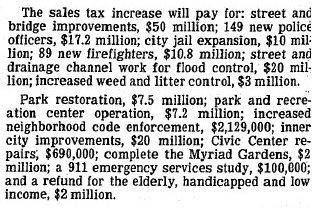 In a June 15 article, Lee Allan Smith, chair of the Oklahoma City Chamber, said that the ballot is "the most important election in the history of Oklahoma City." The largest item on the ballot was the 4-year sales tax, projected to raise $152,699,000. A snippet from the June 15 article is at the right.
In a June 15 article, Lee Allan Smith, chair of the Oklahoma City Chamber, said that the ballot is "the most important election in the history of Oklahoma City." The largest item on the ballot was the 4-year sales tax, projected to raise $152,699,000. A snippet from the June 15 article is at the right.Strong opposition existed from council member Jerry Gilbert and the hotel/motel industry which complained that it was unfairly being targeted with raising revenue to maintain Myriad Gardens , among other objections, and many viewed the domed stadium unfavorably. The Six To Fix campaign was aggressive with frequent and splashy ads claiming that the cost to voters would be a dime a day and numerous civic groups supported the measures.
I was unable to locate a legible ballot in the Oklahoman but this non-legible screen capture shows its layout.
Voter returns began appearing during the evening of June 17. Three measures passed; three failed. Click the June 18 headline below to read its associated article.

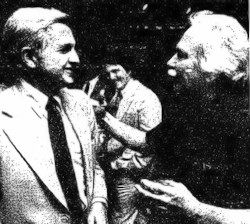 At right, council member Jerry Gilbert is all smiles at a Vote No watch party. Click the graphic for the June 18, 1986, article, part of which reads, "Tax opponents whooped and sang their satisfaction late Tuesday over the apparent defeat of half of the city's tax package. One hotel official described the outcome as 'David slew Goliath.' * * *Opponents let out their biggest screams and laughs over results showing the bond issue for a domed stadium going down hard to defeat. Several started singing a version of 'Happy Days Are Here Again.'"
At right, council member Jerry Gilbert is all smiles at a Vote No watch party. Click the graphic for the June 18, 1986, article, part of which reads, "Tax opponents whooped and sang their satisfaction late Tuesday over the apparent defeat of half of the city's tax package. One hotel official described the outcome as 'David slew Goliath.' * * *Opponents let out their biggest screams and laughs over results showing the bond issue for a domed stadium going down hard to defeat. Several started singing a version of 'Happy Days Are Here Again.'"Ironically, the voters passed the measure which would provide new police briefing stations and equipment but voted no on the sales tax which would have added 149 new officers to staff them. Fire station renovations and improved traffic controls had also passed.
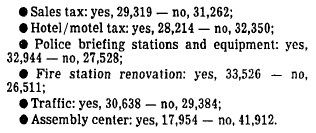 In addition to the sales tax failure, the hotel/motel tax and domed stadium fell in defeat. Click the graphic summary at left for the larger June 19, 1986, full article. The 4-year sales tax was project to garner $152,699,000. The hotel/motel tax was project to produce $1.5 million a year for additional revenue of operating and maintaining Myriad Gardens and convention and tourism promotion; and the property tax measure to raise $38 million for the domed stadium failed to carry.
In addition to the sales tax failure, the hotel/motel tax and domed stadium fell in defeat. Click the graphic summary at left for the larger June 19, 1986, full article. The 4-year sales tax was project to garner $152,699,000. The hotel/motel tax was project to produce $1.5 million a year for additional revenue of operating and maintaining Myriad Gardens and convention and tourism promotion; and the property tax measure to raise $38 million for the domed stadium failed to carry.Why did the larger items not gain approval of city voters? Various reasons were offered. In this June 18, 1986, article, Mayor Coats said that hotel and motel owners worked so hard to defeat the proposed room tax increase they probably pulled the sales tax down with it. The next day's June 19 article council member Pete White wondered whether voters understood that additional police and fire fighters were included in the sales tax. "We don't need those outlying stations if we don't have police to put in them," he said. White also said that opponents had conducted a "gutter campaign."
Thus ended the attempts by Mayor Coats to turn the city around. Even though a popular and energetic mayor who never quit trying, persuading the citizenry in tough economic times to tax themselves, particularly burdened with the albatross of Urban Renewal's illusive retail Galleria, proved insurmountable during his day. At least, the eyes of some may have been opened by what he had done and he may well have set the stage for what was yet to come. And, quite possibly, the series of tax failures may have well afforded Coats' successor, Ronald J. Norick, some lessons worth studying very closely.
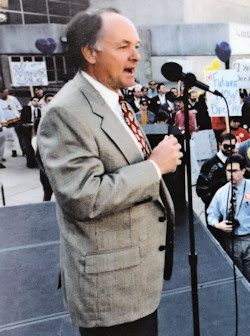 ENTER THE DRAGON-SLAYER: RONALD J. NORICK. One might not suppose by looking that the modest-looking short guy at the right was particularly equipped in the medieval art of killing dragons. Little did we know ...
ENTER THE DRAGON-SLAYER: RONALD J. NORICK. One might not suppose by looking that the modest-looking short guy at the right was particularly equipped in the medieval art of killing dragons. Little did we know ...The City's biography of Norick says, in part,
Under his leadership the City was chosen as a finalist for several large economic developments including a United Airlines maintenance facility. When other cities were chosen for these, Norick focused his efforts on winning passage of the five-year one-cent sales tax to fund the Metropolitan Area Projects (MAPS) program.But, of course, that's the official sterilized word. What else might be observed from the eyes of one who cares less about official versions but cares more about what the records of history reveal? In this instance, the versions will not be remarkably dissimilar, but let's have a look, just the same.
* * *
During Mayor Norick’s tenure, Oklahoma City was twice named one of the ten best-managed cities in the US by Financial World magazine and one of the ten best cities in which to do business by Fortune magazine. Oklahoma City was also rated the most affordable city to live in by U.S. News and World Report magazine.
The Mayoral Campaign. Politics is politics and everything is fair in love and war ... and politics, right? I don't subscribe to that premise, however. I see what is said during political campaigns as being important indicators of a candidate's character — what is one really prepared to do just to get elected? Maybe it's just me, but some parts of this campaign's rhetoric may well present items that Mayor Norick would chose to do differently, had it to be done over again.
Seven candidates announced for mayor by filing time. Click the March 8, 1987, headline below for its associated article which identifies them all and gives a thumbnail report about each.

Now, maybe this is just me thinking like this, and maybe my perceptions are wholly screwed up, but if EVER there has been a city council member with impeccable integrity, adroit and often laid-back skills, it is Pete White (who presently serves as a member of the City Council). As much as I admire what Ron Norick has done and continues to do for this city, and I do, it did not please me one iota to read what was described in the following March 11, 1987, article in which Norick impugned White's character.

Cheap shots are never classy and I always want my city's mayors to be classy. In this instance, I'll give candidate Norick a thumbs down on the "classy" element and side with candidate Pete White who only gave a polite, though pointed, reply.
In any event, Ron Norick won the race on March 17 by achieving a 50.6% vote, thus winning without a runoff. Councilman White was second with 31.6%. Then, in a remarkable show of unity, the two candidates held a joint reception on March 28 to raise money together to pay off unpaid campaign debts.
Interestingly, in Ward 6, Beverly Hodges narrowly defeated Jerry Gilbert's re-election -- some thought that Gilbert had doomed Mayor Coat's Six To Fix campaign.
Norick's First Months. Perhaps as an indicator of things to come, one of Norick's 1st decisions was to abolish all nine existing standing committees as well as various ad hoc committees of the City Council. His campaign slogan was, "Norick means business," and it seems that he did. See this April 15 article. A May 20 article reported that he was forming an advisory committee to develop a comprehensive plan for the city, the first since 1977. Faced with shrinking revenues, Norick sought means to reduce city expenses — such as by a 1 hour weekly unpaid furlough for non-uniformed city employees and reduction of the number of city employees hopefully through attrition. See this May 28 article. In this June 5 article he was reported to favor reducing city employee fringe benefits and he opposed an across the board pay increase for city employees that City Manager Terry Childers had proposed, at a time that some employees would lose their job because of the need to reduce city expenses.
On three occasions during Mayor Coats' term, citizens had substantially refused to increase their taxes, and it was payback time. Faced with a shortfall of $5.8 million in projected revenue, those left to deal with those decisions had to form a fiscal budget, and it wasn't going to be easy, as reported in the June 7 Oklahoman — click the headline below for the full article.

The budget did get approved — council member Jackie Carey returned to the city while on vacation in Germany to be sure that Myriad Gardens funding was not cut (favored by Mayor Norick) and then flew back to Germany. This June 10 article gives the report. In a June 12 article, it was reported that Mayor Norick, perhaps disgruntled that the budget did grant city employees an across the board pay raise and continued funding levels for the Myriad Gardens, effectively said in a self-called press conference that, "Wait until next year." As for pay raises, he'd have none of that but the City Council approved them over his strong objection, according to this July 1 article. In the article, the mayor was quoted as saying,
The increases were bitterly opposed by Mayor Ron Norick, who said about one wage agreement, "whoever write this contract ought to be in the AFL-CIO hall of fame."Contentiousness on City Council continued ... click the July 10 headline below for the report ...
* * *
He was particularly opposed to increases for management. The 4.1 percent to 5.1 percent raises high-level supervisors will receive is "pretty good for a broke business," Norick said.

Recent Oklahoma City Council meetings have been trying. Tuesday the council wrestled for more than five yours with an agenda that was four inches thick and weighed a hefty 10 pounds. ¶ It contained several controversial items as well as reviews of nearly all the city's yearly contracts for goods and services. ¶ The ponderous agenda only added stress to the meeting. Council members were already upset because they had received it just three days before having to vote on it Tuesday.Thus far into Mayor Norick's 1st term, while he certainly showed himself as an independent thinker and more than amply revealed his feisty side, he had clearly not taken charge.
* * *
On Tuesday Councilman Goree James threw a plastic coffee stirrer at Purser following an exchange of remarks over the economic prowess of Purser's northwest Oklahoma City constituents vs. those of James on the northeast side. The stirrer fell short of its mark. The verbal barbs did not.
Perhaps in this time, he learned that, although he was mayor, his one vote did not trump any other member of the City Council. When all was said and done, his position as mayor actually included no superpowers. If his position afforded him anything special, it would be the element of bully-pulpit, the opportunity to lead and bring council members, and the city, together, on a quest.
That dragon-slayer time for Mayor Norick would come, but it was certainly not in hand during the first months of his administration. Meanwhile, while the rancor at city hall continued on, the capital improvement needs of the city were not being met, and that was the direct result of citizen votes on taxing proposals during Mayor Coats' term. As an example, this September 10 article reported on the dilapidated conditions of the Myriad Convention Center and how the city was losing convention business on that account.
In this time, Mayor Norick had not yet formed a city-vision to elevate and capture the minds and hearts of Oklahoma Citians — in this time, he was preoccupied with his own views about making city government accessible to public participation, balancing city budgets, dealing with shrinking revenues, and perhaps being out of harm's way when council members might toss harmless missiles at one another during council meetings. All good things. But, in the larger scheme of things, these were the mundane and pragmatic roles of mere mortals, not those with special gifts which might be used in capturing the fancy of a city as to what it might become.
In this time, Oklahoma City remained possessed by the circling dragons which had been developing since the Oil Bust in 1982:
- Low city self-esteem
- Low city hope for the future
- Continuing diminishment of the importance of downtown
[Article in progress]































4 comments:
Thanks for your great article. There is so much junk on the internet it is hard to find good quality information when you really need it. I just came across your site and have bookmarked it. Look forward to reading more in the future keep us posted.
Thanks, Andy. This article remains undone ... hopefully in a few days I'll get it finished.
Interesting...in the "2 Mayoral Candidates Skirmish" article, the question posed wasn't really answered: "I want to know why $120,000 was paid to the municipal councilor, who is already on the payroll of Oklahoma City, for fees?"
Not only is it interesting that the question wasn't really answered, but a similar situation would come up under the original MAPS. Not sure if Norick was still mayor then or Humphreys.
As a side note Doug, some of the "visual" links to articles are broken?
Larry OKC
Thanks, Larry. About broken links, there are so many links in this article ... I spot checked about 10 right now but couldn't find one that wouldn't work. Can you identify broken links for me? I'll fix them if I can.
Post a Comment